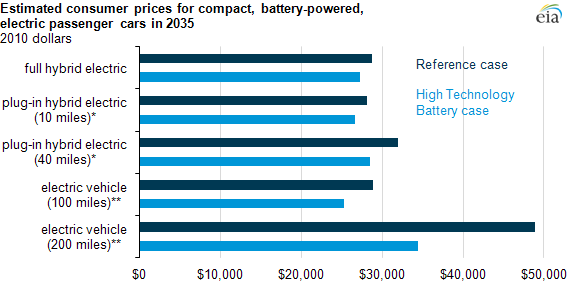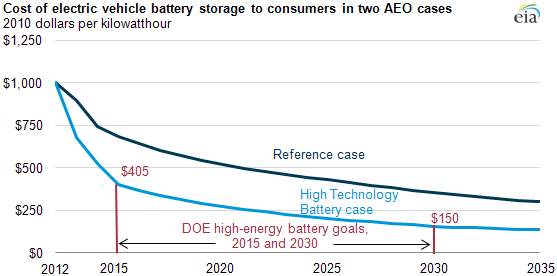
EIA’s AEO2012 includes analysis of breakthroughs in vehicle battery technology

*The mile amount given indicates how far these vehicles will travel on electric battery power alone before switching to a mixture of battery and internal combustion.
**The mile amount given indicates how far this vehicle will travel on a single full charge.
Download CSV Data
The U.S. Energy Information Administration's (EIA) Annual Energy Outlook 2012 (AEO2012) includes a High Technology Battery case that examines the potential impacts of significant breakthroughs in battery electric vehicle technology on the cost and price of all types of battery powered electric vehicles, which in turn affects projected vehicle sales, energy demand, and carbon dioxide (CO2) emissions.
There are three major battery-powered electric vehicle types presented in the chart above:
- Full hybrid electric (HEV): Vehicles that combine an internal combustion engine (ICE) with electric propulsion from an electric motor and battery. HEVs are not plugged into electrical outlets for recharging. HEV example: Toyota Prius
- Plug-in hybrid electric (PHEV): Vehicles with larger batteries to provide power to drive the vehicle for some distance in charge-depleting mode (the battery is being drained faster than it can recharge). When a minimum level of battery power is reached, a PHEV will operate on a mixture of battery and internal combustion power. PHEVs also can be engineered to run in a "blended mode," using an onboard computer to determine the most efficient use of battery and internal combustion power. PHEV example: Chevrolet Volt
- Plug-in electric (EV): Vehicles that operate solely on an electric drive train with a large battery and electric motor and do not have an internal combustion engine to provide motive power. EV example: Nissan Leaf
EIA data for the residential sector show that about half of vehicle owners park within 20 feet of an electrical outlet, which affects market potential for PHEV and EV electric vehicles that must be plugged in. A widespread, publicly-available charging infrastructure, which could expand the market potential for these vehicles, was not assumed as part of the High Technology Battery case.
Relative to the Reference case, the prices of HEVs and PHEV10s in the High Technology Battery case are 5% below the price in 2035. For PHEV40s, the price is 11% lower, and for the EV100 and EV200s, the prices are 13% and 30% lower, respectively.
If the major developments in battery system prices projected in the High Technology Battery case were to take place, the cost per kilowatt hour (kWh) to consumers of such battery storage drops to $135 by 2035, as opposed to $304 per kWh projected in the Reference case (as shown in the graph below). These major battery developments include: reducing the cost of battery and non-battery systems as well as solving battery life-cycle and overheating limitations, allowing total battery energy storage capacity to shrink. As these breakthroughs occur, it is assumed that battery electric vehicle technology permeates into a wider range of vehicle size classes for passenger cars and light-duty trucks. Battery electric vehicles, excluding mild hybrids, grow from 3% of new light-duty vehicles (LDV) sales in 2013 to 24% in 2035 in the High Technology Battery case, compared with 8% in 2035 in the Reference case.

Download CSV Data
Although many breakthroughs in battery technology are possible, there are still several obstacles to greater market penetration of battery-powered vehicles:
- Prices. Prices for battery electric vehicles, even by 2035 with the assumption of technology breakthroughs, are above those for conventional gasoline counterparts. However, many consumers may be willing to pay more for vehicles that have lower fueling costs.
- Recharging times. Recharging times differ dramatically depending on the voltage of the outlet. Typical 120-volt outlets can take up to 20 hours for a full EV battery recharge; a 240-volt outlet can reduce the recharging time to about seven hours.
- Efficiency gains by conventional gasoline vehicles. The increase in fuel economy for conventional gasoline vehicles and other types of alternative fuel vehicles decreases consumer refueling costs. This lower cost in turn will decrease the economic payback of electric drive train vehicles, reducing the difference in savings between conventional gasoline vehicles and battery-powered electric vehicles.